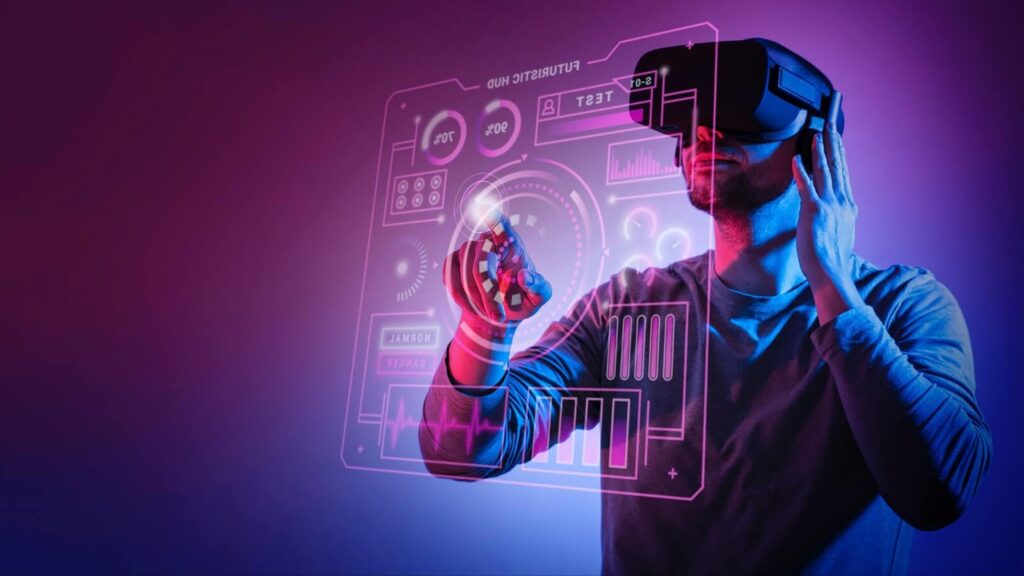October 6, 2022
How to Create Your Own Metaverse Virtual World?
Table of content
The term Metaverse has gained popularity during the last few years thanks to the increased use of cryptocurrencies and COVID-19 restrictions. Even though the announcement that Facebook was being renamed Meta was received with skepticism and excitement, now people understand the importance of Metaverse and its potential uses for a bright future.
Experts define the Metaverse as a new way to connect people virtually that may even potentially replace its equivalent in the physical world. While there are still some debates over the use-case of an extravagant virtual reality, numbers show exceptional interest in this virtual world. According to the source, the global metaverse market was estimated at $63.83 billion. Experts predict that the market will grow at a CAGR of 47.6%.
Even though Metaverse has already become popular enough, experts believe that we will soon see how many opportunities it has to offer. One of the reasons for that is that the new version of the internet, Web 3.0, gives NFTs and blockchains new hope. We created this article to help you understand how to create your own Metaverse and why a metaverse launch will let your business grow.

Characteristics of Metaverse
Infinite
It is vital to note that this statement should not be meant as metaphorical or symbolic. The key thing you need to know about Metaverse is that it is literally an infinite space. This means you can keep adding more and more spaces for participants to enjoy. Even if one area within this virtual world ends, it usually means that developers stop building more environments rather than an actual physical space limitation.
Real Connections
Even though Metaverse gained popularity only recently, the first Metaverse concert was held in India. However, it was attended by only 25-30 people since digital accessories still haven’t been used. Nevertheless, this market is growing rapidly, and high-quality VR sets and other paraphernalia will soon be available at competitive rates. It is worth noting that the uses of Metaverse are far beyond virtual concerts. Organizations and well-known brands can also benefit from investing in Metaverse since this space offers real connections between avatars. Experts believe that soon this industry will allow social networking, office meetings from home, dating, meeting new people, or even hanging out with friends in a specific place virtually, among many other opportunities.
Always Live
A vital characteristic feature of the Metaverse is that it is always live. Therefore, you won’t be able to turn it off once it is launched. As a result, this feature makes the Metaverse similar to the real world, which allows people to interact with each other and attend events regardless of the location and time of the day. Even though a small enclave of the Metaverse can still be damaged or deleted if the server is destroyed, the Metaverse isn’t stored in the conventional digital sense of the word; thereby, it cannot be destroyed.
Decentralization
While interoperability allows for asset exchange across virtual worlds and experiences, decentralization controls the power of these virtual worlds, assets, and experiences. The vision of the web future has always been about complete decentralization, meaning the power is in the hands of users rather than companies or governments who can use centralized platforms to control, exploit and manipulate users. Metaverse is controlled by no one yet owned by every interested party.
Key Technologies Used in Metaverse Development
1. Blockchain
Metaverse is based on blockchain technology. Even though Metaverse can be centralized, its use cases, such as NFT development and cryptos, are designed to replace the centralized concept of Metaverse with a potent decentralized infrastructure. Blockchain will also play a vital role in metaverse development since the future of Web 3.0 is all about decentralization.
2. AR and VR technologies
Augmented Reality (AR) and Virtual Reality (VR) provide access to the Metaverse. These technologies are the gigantic engines needed to support the development of the metaverse project that can facilitate immersive experiences and offer increased satisfaction for users.
Virtual reality Metaverse is known for the connected experience users get in the Metaverse. For example, a shared meeting is one of the brightest examples that demonstrate the use of VR technology in allowing connected experiences. VR technology will utilize other technologies over time to increase user engagement, boost its existing application and enhance the ability of Metaverse to offer immersive 3D experiences.
3. Artificial Intelligence
Artificial intelligence is another critical technology needed for metaverse development. By adding AI, companies can replace human activities with computer-controlled automated algorithms. The key use of AI for organizations is fast computing, identity verification via facial recognition, data analytics, as well as improved business strategies. Thanks to AI’s implementation in the Metaverse, it may support the design of 2D and 3D-based Avatars based on specific characteristics of users.
4. 3D Reconstruction
Since Metaverse is designed to represent the real world but in virtual format, it should also offer realistic virtual spaces developed using 3D reconstruction technology. 3D reconstruction allows for the creation of photorealistic objects like buildings, a high-definition 3D environment, as well as physical locations within the Metaverse based on the basic laws of science.
Even though 3D reconstruction in the virtual world is quite a mature concept, the idea has greatly evolved in recent years. For example, industries such as real estate and e-commerce can be integrated into the Metaverse.
5. IoT- Internet of Things
Finally, IoT technology acts as a medium connecting the real world with the internet through a vast range of sensors and devices. IoT improves the connection between real-world and Metaverse objects or devices. When connected to the Metaverse, IoT devices can easily share and get data to boost Metaverse replication of the physical world.

Important Standards and Requirements for Creating Metaverse
The internet that we all know and use today works on a list of specific standards and protocols for visual presentation, graphics, communication, data, and so on. The modern internet is the base of any real-time communication between servers and browsers of the internet. However, the Metaverse will require an even more complex and secure set of interoperability and live synchronous experience.
Before exploring how to build a metaverse, you should first learn the standards and requirements. Metaverse requires standardizing some standards around a tinier set per function. While Web3 is developed based on open standards & protocols, the lion’s share of it is closed and proprietary. These open standards provide interoperability between vendors within one industry, while the Metaverse will require interoperability across all industries. Therefore, knowing some standards that will be required during Metaverse development can help you understand the situation. Below you will find key standards and requirements if you want to create Metaverse:
- Open and interoperable standards for all media, including text, images, video, audio, 3D scenes, 3D items, 3D sequences, and 3D apps supporting vectors.
- Open programming languages are HTML, WebXR, WebAssembly, JavaScript, and WebGPU Shader Language.
- Extended Reality (XR) allows real-and-virtual combined environments and human-machine interactions that are generated by software technology with hardware like smart glasses, Omni treadmills, haptic gloves, VR headsets, cameras, as well as scanning sensors.
- Blockchain and smart contracts development for transparency, security, and permissionless transactions.
- Computing power to support data processing, projection, AI, etc.
- 3D immersive simulations of various virtual worlds featuring real-world environments and ecosystems.
- A list of payment gateways that support digital currency exchanges and payments within flat currencies and cryptocurrencies.
How to Create Your Own Metaverse? Step-by-Step Guide
Now let’s explore how to make a Metaverse through several steps:
Search & Definition of an Idea
Just like with any other project, the development of the Metaverse and its applications should always start with a search and idea definition. Even though It doesn’t have to be groundbreaking or VR / AR-related, you still have to develop a clear idea of how your Metaverse is going to work and what benefits it will bring to users. Even though all Metaverse is similar in some ways, each brings specific ways users interact and platforms they can use.
Find a Development Company
The next step is finding your trusted development provider. While you may create your in-house team, outsourcing your project to an experienced team or hiring a dedicated team are the best options in this case. That is because building Metaverse is a challenging task that requires a specific set of skills and smart contract development.
We also recommend checking the company’s portfolio. For instance, if you are going to launch a Metaverse game, look for a company with relevant experience. Check trusted third-party services, like Upwork, to see how other clients estimate the company’s experience and work.
Business Analysis
Before you let your chosen development team start the project, you will also need to consider the business part of the future project. You can’t start building your Metaverse product without knowing your market, customers, and competitors. Even though you can perform business analysis on your own, it is a common practice in trusted development companies to offer business analytics to help you cover this task.
According to the information received, you, the business analyst, project manager, and head of development should draw up a technical task. This represents a list of functions and requirements for the future project. This reduces the development time and allows you to more accurately determine the scope of the upcoming work and resources needed and determine the optimal technology stack.
UX / UI Design
This stage is responsible for creating the architecture of the system. This step involves the development and optimization of user flows and the design of user interfaces. This task should be done by your UX/UI team. However, it is vital to start with prototypes as they will provide an animated visualization of the interface.
Writing Metaverse Application Code
Finally, the development stage. Here your dev team will write the Metaverse application. They will build the front-end and back-end parts while also integrating external services like payment gateways or liquidity pools. We recommend using the Agile methodology since it has been shown to speed up the development, reduce cost and minimize bugs.
Test & Release
The testing part is done by QA specialists. They test the exciting product for bugs, functionality, usability, compliance with the requirements, and so on. The QA team will also test your smart contracts if they exist. When the app is developed and tested, you will need to deploy it and launch it. This will require a few more days or a month of real-time and several hundred dollars.
Product Support
Even though some believe that launching the product is the final stage of development, the truth is that you will always need to support and maintain your product. You need to collect user feedback and timely resolve all questions that users face.

How Much Does it Cost to Create a Metaverse Virtual World?
There is no accurate answer to this question. However, we will take an average cost of Metaverse development. The price may vary from $50,000 to $300,000, depending on many factors, like:
- Complexity;
- Idea;
- Timeframes;
- Development company;
- Development approach;
- Location of developers.
How Can We Help?
Interexy is on the list of top Dubai & Miami Blockchain development companies that also partners with Sandbox for all NFT launches. Being experts in blockchain development services, we offer clients developers and other specialists with unique skill sets, experience, and relevant backgrounds. Since our development team comprises only highly-skilled engineers, our clients get personalized approaches each time. In addition, we offer flexible choices, allowing clients to choose the cooperation model. Depending on your business goals and task, you can hire developers to expand your team, hire a dedicated team or outsource the entire project.
Final Thoughts
Metaverse development is growing in popularity. With the increased use of cryptocurrencies and NFTs, Metaverse uses will also grow in upcoming years. However, not everyone knows that Metaverse development slightly differs from other projects. Knowing how to build your own Metaverse through the steps and rules needed to follow can help you get a clear picture. If you have any questions or want to share your idea, book a call with our experts!
FAQs
Can I build my own Metaverse?
Yes, you can. However, you will need a development team to realize your idea.
What technologies are used to create the Metaverse?
Many technologies are needed to create your own Metaverse, including blockchain, VR, AR, AI, and IoT.
How much does it cost to build a Metaverse?
There is no simple answer, as the price depends on many factors. However, the development of Metaverse starts from $50.000.















